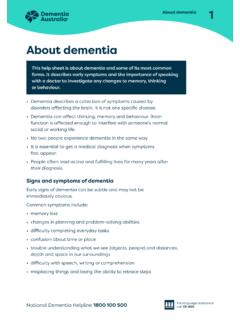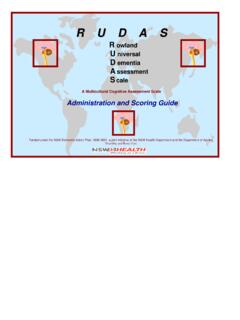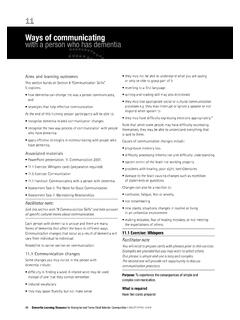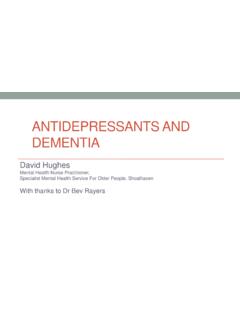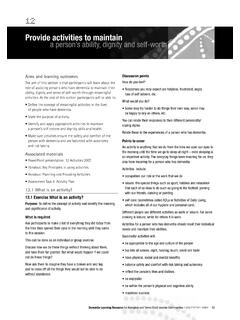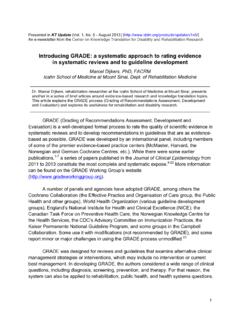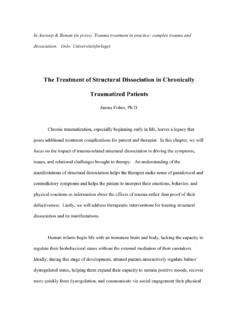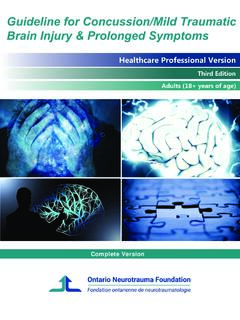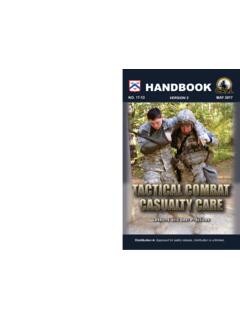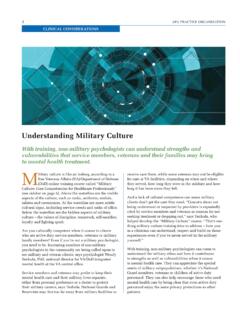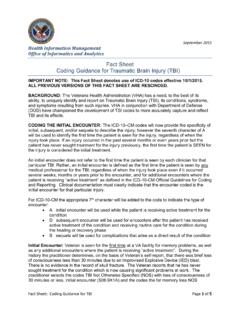Transcription of Dementia Q&A 11 - Diagnostic criteria for dementia
1 Dementia Q&A11 For language assistance call 131 450 National Dementia Helpline 1800 100 500 Diagnostic criteria for dementiaThis sheet provides information about the Diagnostic criteria for Dementia and related conditions, and the use of biomarkers for earlier and more accurate are the Diagnostic criteria ? Diagnostic criteria for Dementia incorporate the scientific knowledge and technological advances gained in recent times and reflect the contemporary state of understanding regarding the detection and diagnosis of Dementia and related disorders characterised by cognitive impairment. In 2011, the National Institute on Aging and the Alzheimer s Association (NIA/AA) in the United States published new Diagnostic guidelines for Alzheimer s disease. The original guidelines had not been updated for 27 years.
2 The aim of the new guidelines was to improve current diagnosis, and establish research priorities for the future. In 2013, the American Psychiatric Association published the fifth edition of the Diagnostic and Statistical Manual of Mental Disorders (DSM-5). Dementia was renamed major neurocognitive disorder in the DSM-5, which also recognises earlier stages of cognitive decline as mild neurocognitive disorder . The aims of this reclassification include reducing stigma associated with Dementia and bringing the Diagnostic guidelines into line with current clinical practice. The newer NIA/AA guidelines and the DSM-5 revisions have many similarities; however, the NIA/AA guidelines have a primary focus on future research directions, while the DSM-5 focuses exclusively on clinical diagnosis. Further, the NIA/AA guidelines are for diagnosis of Alzheimer s disease only, while the DSM-5 includes Diagnostic criteria for various causes of cognitive impairment, or forms of Q&A11 Page 2 of 11 Diagnostic criteria for dementiaAnother major Diagnostic guideline is the International Classification of Diseases (ICD) published by the World Health Organisation.
3 ICD-11 was released in June 2018. ICD-11 adopted the terminology neurodevelopmental disorders and very similar Diagnostic criteria to those of the introduction of neurocognitive disorders in these documents does not mean that Dementia is not an appropriate term to use. In fact, the DSM-5 includes or Dementia in parentheses when referring to major neurocognitive disorder, in recognition of Dementia s history and and Statistical Manual of Mental Disorders fifth editionDementia was named major neurocognitive disorder (NCD) in the DSM-5. However, the term Dementia may still be used as an acceptable alternative. The two terms are essentially different labels for the same condition; major NCD is equivalent to Dementia . The DSM-5 also recognises a less severe level of cognitive impairment, mild NCD, which now provides a diagnosis for less disabling syndromes that may nonetheless be causing concern and could benefit from treatment.
4 mild NCD is equivalent to mild cognitive impairment (MCI) and to prodromal Dementia , again different labels for the same condition. DSM-5 provides Diagnostic criteria for both major NCD and mild NCD, followed by Diagnostic criteria for the different subtypes or causes of NCD. Although the threshold between mild NCD and major NCD is inherently arbitrary, the two levels of impairment are considered separately for consistency with other fields of medicine and to capture the care needs of people living with are characterised by cognitive impairment as the most prominent and defining feature of the condition. The term cognitive broadly refers to thinking and related processes, and the term neurocognitive was applied to these disorders to emphasise that brain disease and disrupted brain function lead to symptoms, and that, in most cases, such disruption can be reliably measured.
5 NCDs are also characterised by acquired deficits, which represent a decline from previous functioning, rather than neurodevelopmental deficits present from birth or early Q&A11 Page 3 of 11 Diagnostic criteria for dementiaA listing of cognitive domains is also provided in DSM-5, to guide clinicians in establishing the presence of NCD, distinguishing between the major and mild levels of impairment, and differentiating among subtypes. The DSM-5 details six cognitive domains which may be affected in both mild and major NCD: Complex attention, which includes sustained attention, divided attention, selective attention and information processing speed Executive function, which includes planning, decision making, working memory, responding to feedback, inhibition and mental flexibility Learning and memory, which includes free recall, cued recall, recognition memory, semantic and autobiographical long term memory, and implicit learning Language, which includes object naming, word finding, fluency, grammar and syntax, and receptive language Perceptual-motor function, which includes visual perception, visuoconstructional reasoning and perceptual-motor coordination Social cognition, which includes recognition of emotions.
6 Theory of mind and insightMild neurocognitive disorderMild NCD is a Diagnostic category in the DSM-5, added to recognise the substantial clinical needs of individuals living with this disorder, which might also be termed mild cognitive impairment (MCI) or prodromal Dementia . Diagnosis of MCI has become increasingly common in clinical practice, partly because people with cognitive decline are seeking assessment and treatment earlier, before a diagnosis of Dementia is justified. The move to diagnose NCDs as early as possible also emerged from the recognition of a long predementia stage in neurodegenerative diseases such as Alzheimer s, improvements in early diagnosis, and the increasing emphasis on early intervention to prevent or postpone Dementia . Importantly, mild NCD is not always a precursor of major NCD, and the diagnosis does not require further decline.
7 There may be continued decline, as in neurodegenerative diseases, or the impairment may be static or even improve, as in traumatic brain Q&A11 Page 4 of 11 Diagnostic criteria for dementiaDiagnosis of mild NCD requires evidence of modest cognitive decline from a previous level of performance in one or more of the cognitive domains outlined above. These cognitive deficits must be insufficient to interfere with independence in daily activities, although greater effort and compensatory strategies may be required to maintain the level of independence. Further, the cognitive deficits must not be due to another mental disorder (such as depression).Major neurocognitive disorder Diagnosis of major NCD requires evidence of significant cognitive decline from a previous level of performance in one or more of the cognitive domains outlined above.
8 Additionally, the cognitive deficits must be sufficient to interfere with independence in activities of daily living. The cognitive deficits must not be attributable to another mental disorder. The criterion of maintenance or loss of independent functioning represents the key distinction between mild and major introduction of major NCD as an alternative term for Dementia was prompted by a desire to address the limitations of and the stigma associated with the term Dementia . Dementia is most commonly used to refer to older people, has become synonymous with Alzheimer s disease and memory loss, and has negative connotations in part due to its literal meaning without mind . It is hoped that major NCD more accurately captures the many different causes and manifestations of significant cognitive impairment that can affect people at any of neurocognitive disorders Diagnosing mild or major NCD should be followed by an examination of potential causes so that a subtype can be assigned.
9 In many people with NCDs, there is evidence of a causative disorder, such as Huntington s disease or HIV infection. In others, the cognitive symptoms emerge first and progression provides evidence of a causative disorder such as Alzheimer s disease or Lewy body disease. In many cases, especially for older people, there are multiple causative factors, and the diagnosis should recognise this. Subtypes of minor and major NCD in the DSM-5 include: Dementia Q&A11 Page 5 of 11 diagnostic criteria for dementia Major or mild Neurocognitive Disorder Due to Alzheimer s Disease Major or mild Frontotemporal Neurocognitive Disorder Major or mild Neurocognitive Disorder With Lewy Bodies Major or mild Vascular Neurocognitive Disorder Major or mild Neurocognitive Disorder Due to Traumatic Brain Injury Substance/Medication-Induced Major or mild Neurocognitive Disorder Major or mild Neurocognitive Disorder Due to HIV Infection Major or mild Neurocognitive Disorder Due to Prion Disease Major or mild Neurocognitive Disorder Due to Parkinson s Disease Major or mild Neurocognitive Disorder Due to Huntington s Disease Major or mild Neurocognitive Disorder Due to Another Medical Condition Major or mild Neurocognitive Disorder Due to Multiple
10 Etiologies Unspecified Neurocognitive DisorderOne key element of all sub-types is the removal of the requirement for memory impairment as a criterion for all is an increasing understanding that other cognitive domains, such as language or attention, may be impaired first, or exclusively, in other NCDs, depending on which parts of the brain are affected by the underlying National Institute on Aging/Alzheimer s Association Diagnostic guidelines for Alzheimer s diseaseThe NIA/AA Diagnostic guidelines for Alzheimer s disease (AD) were designed to reflect research which indicates that AD begins affecting the brain many years before problems in memory, thinking and learning are noticeable. This means that if we can develop ways to detect and treat the disease in the pre-symptomatic stage, we can prevent symptoms occurring, prevent phases of AD progression are outlined preclinical AD (where the disease is present in the brain but there are no symptoms), mild cognitive impairment due to AD (also called prodromal AD), and Dementia caused by AD.
